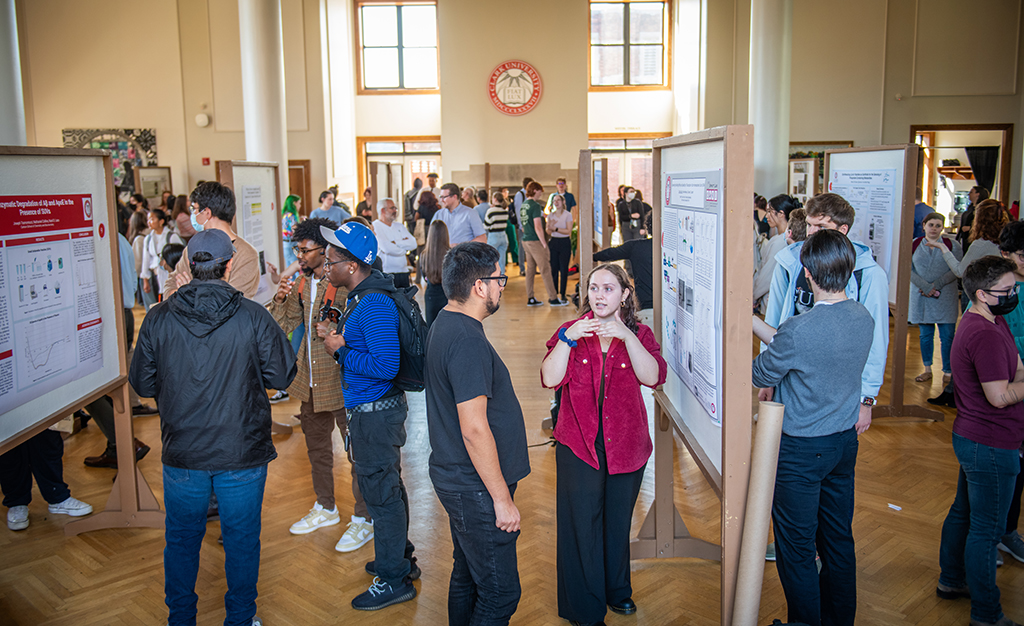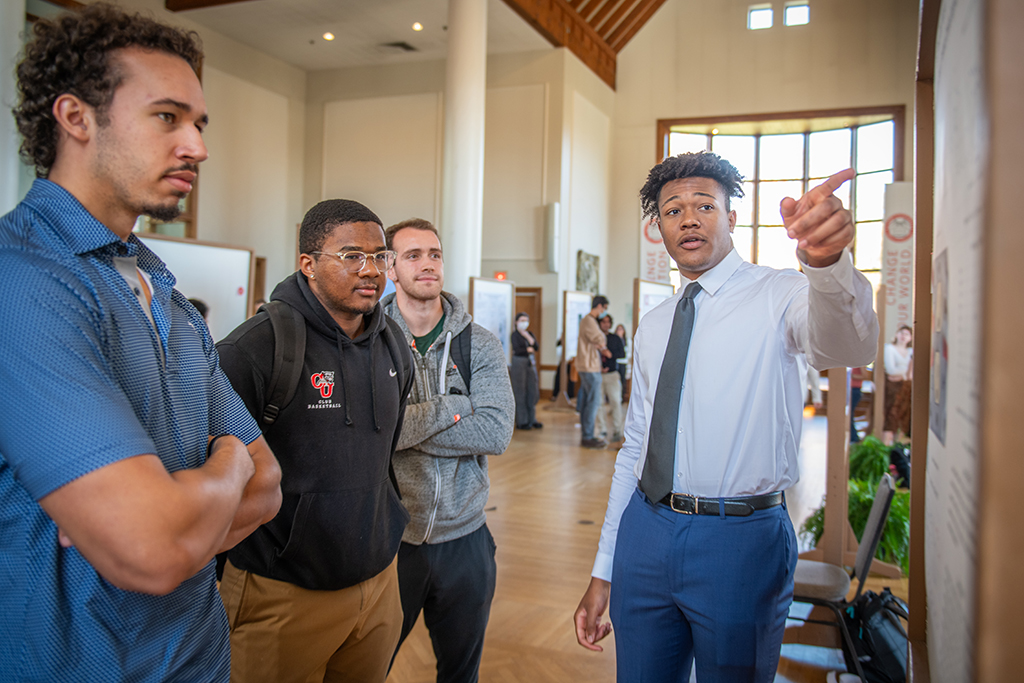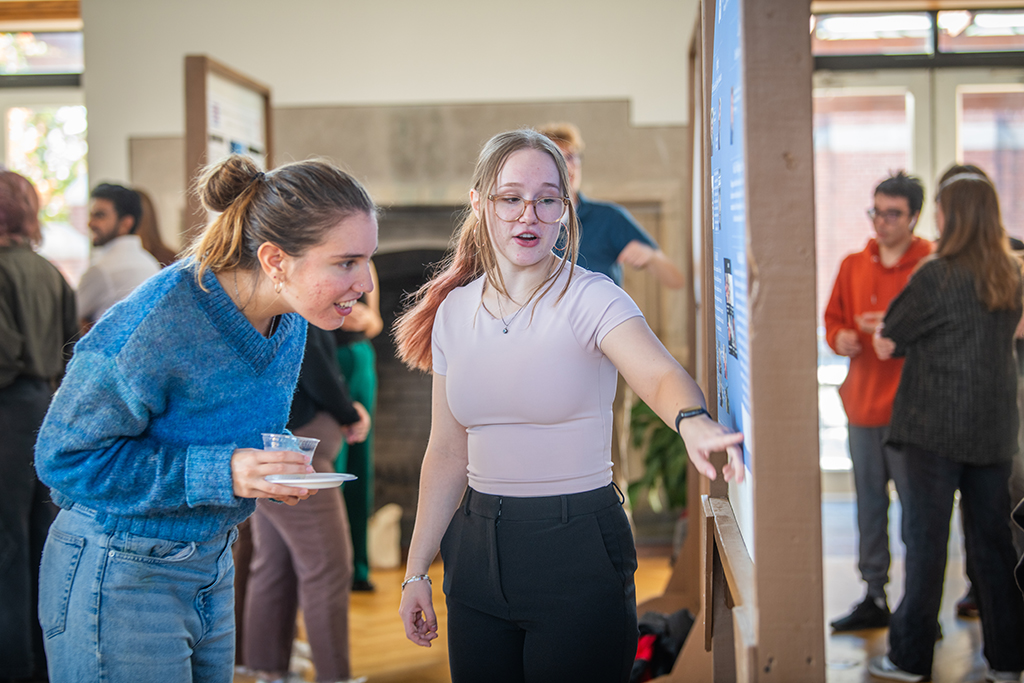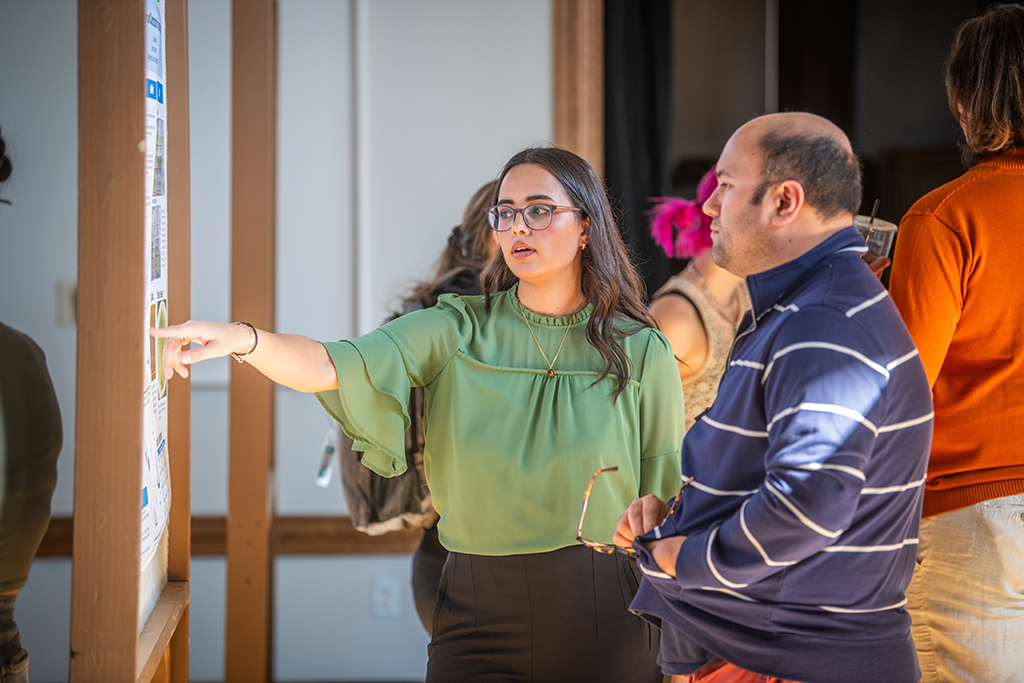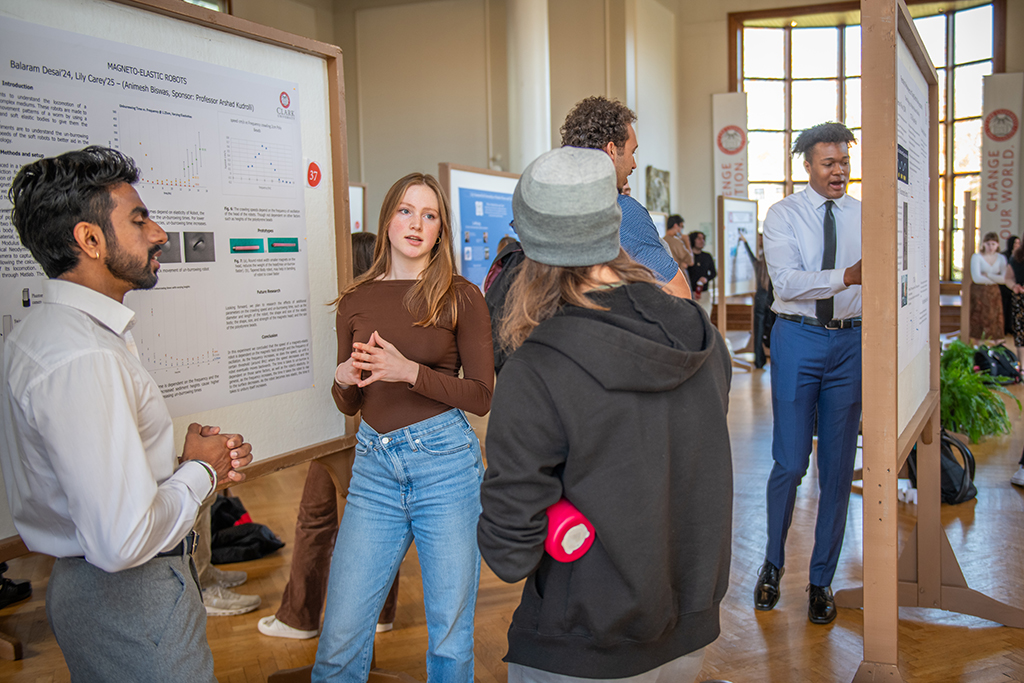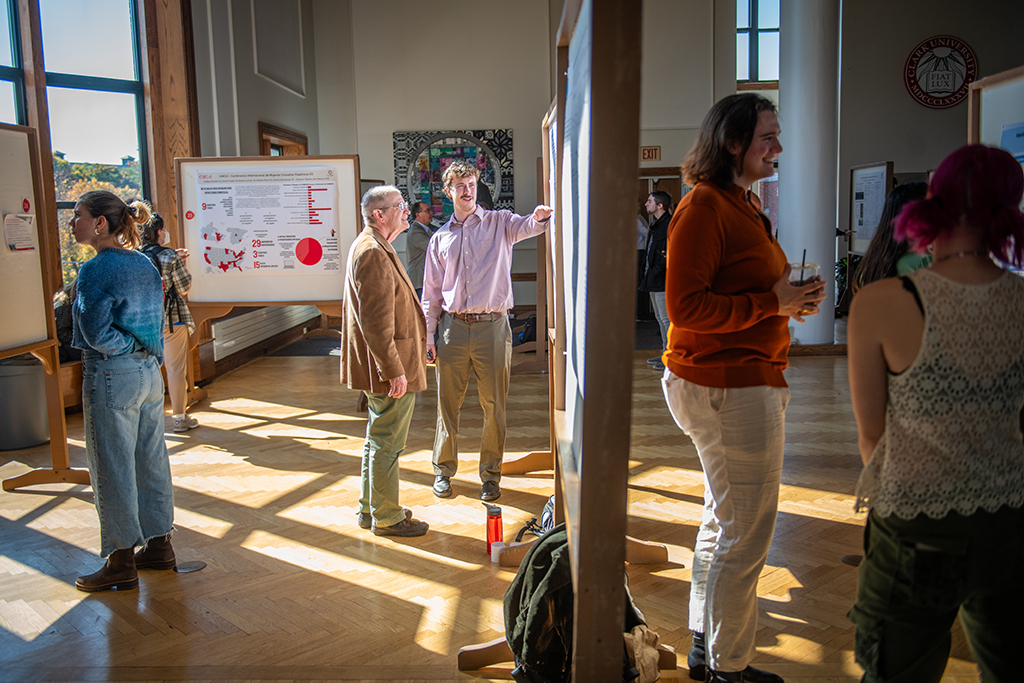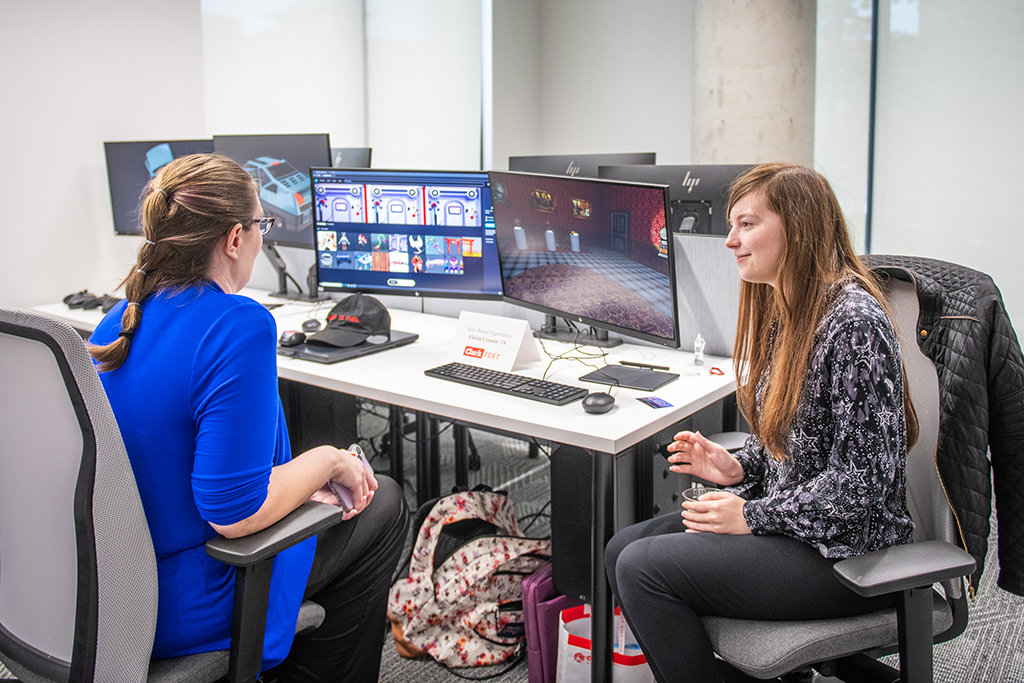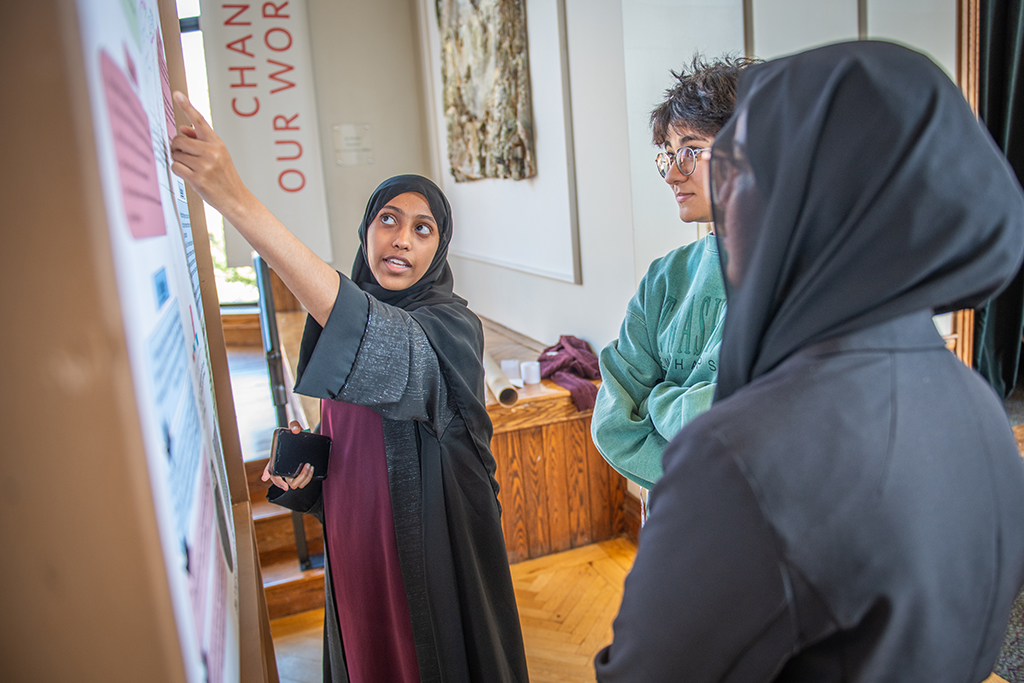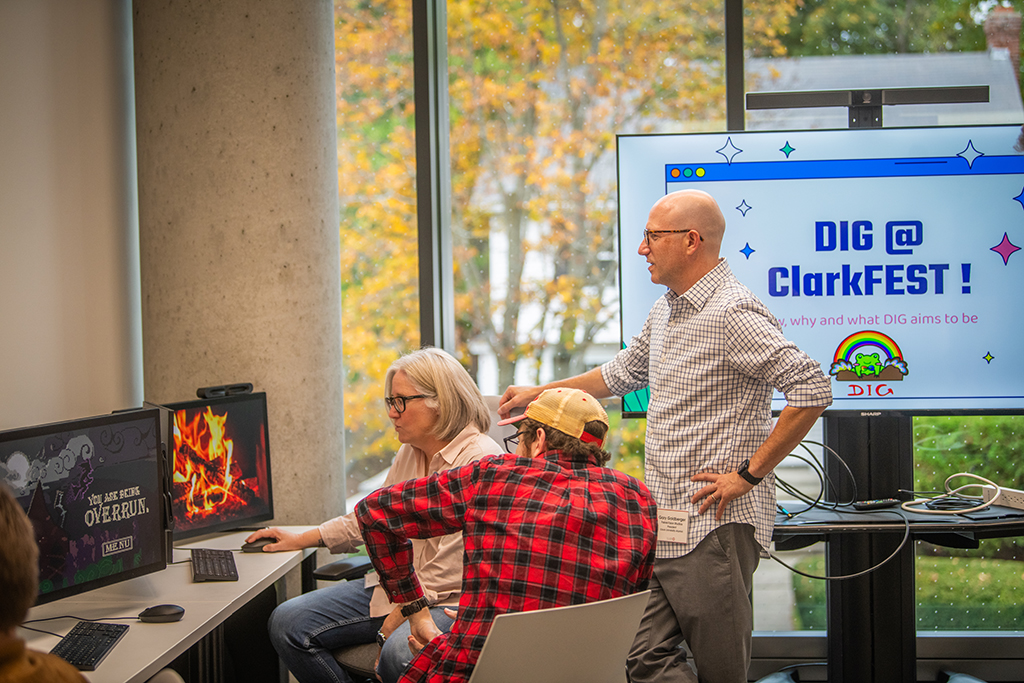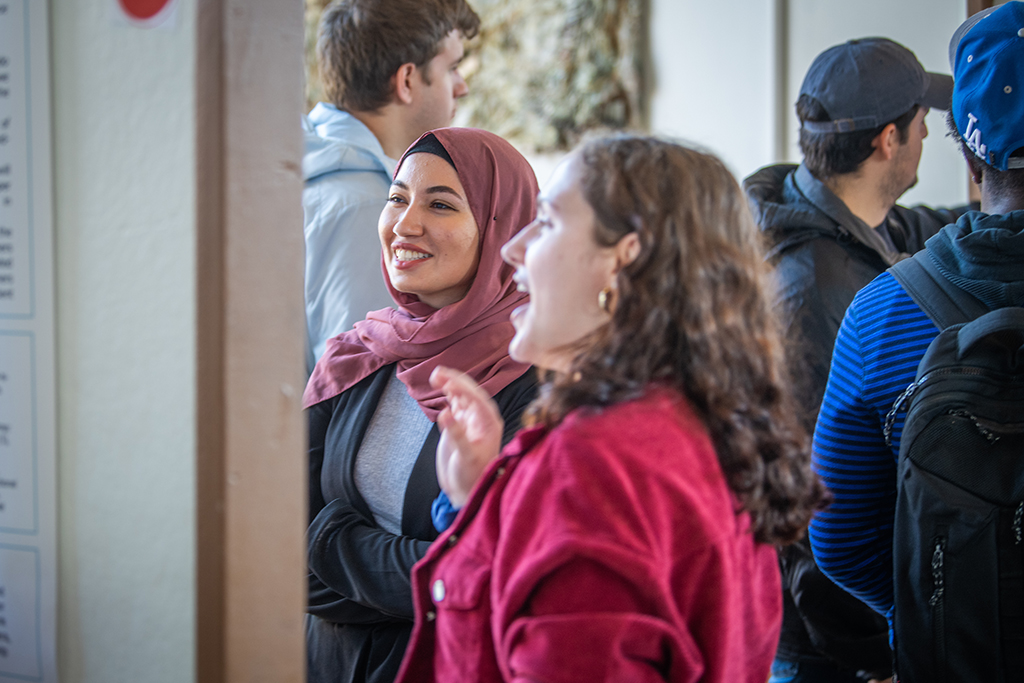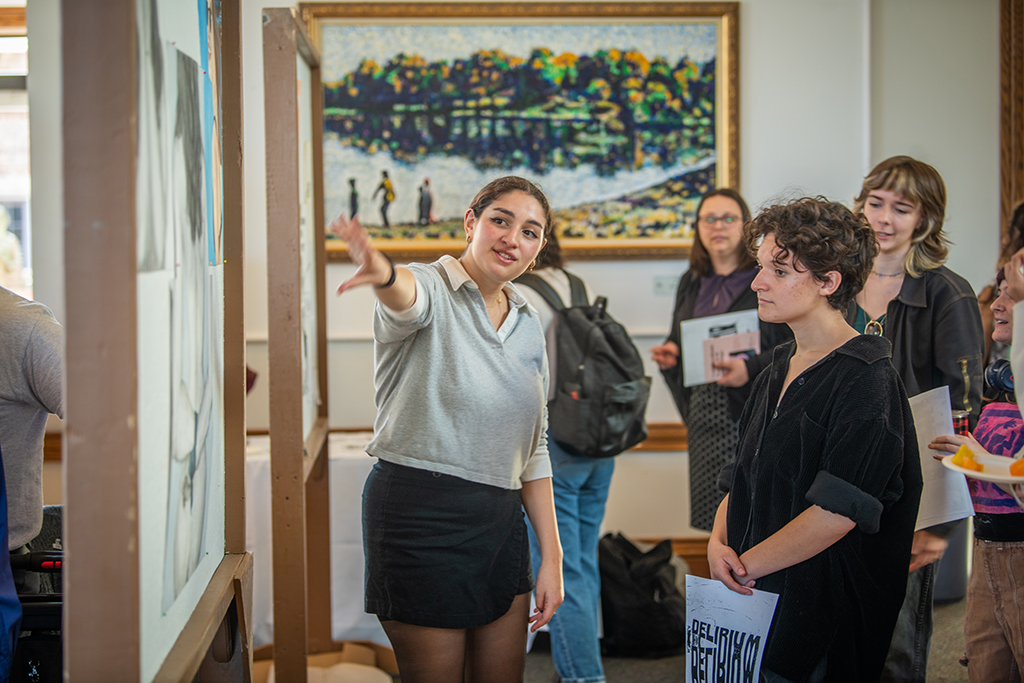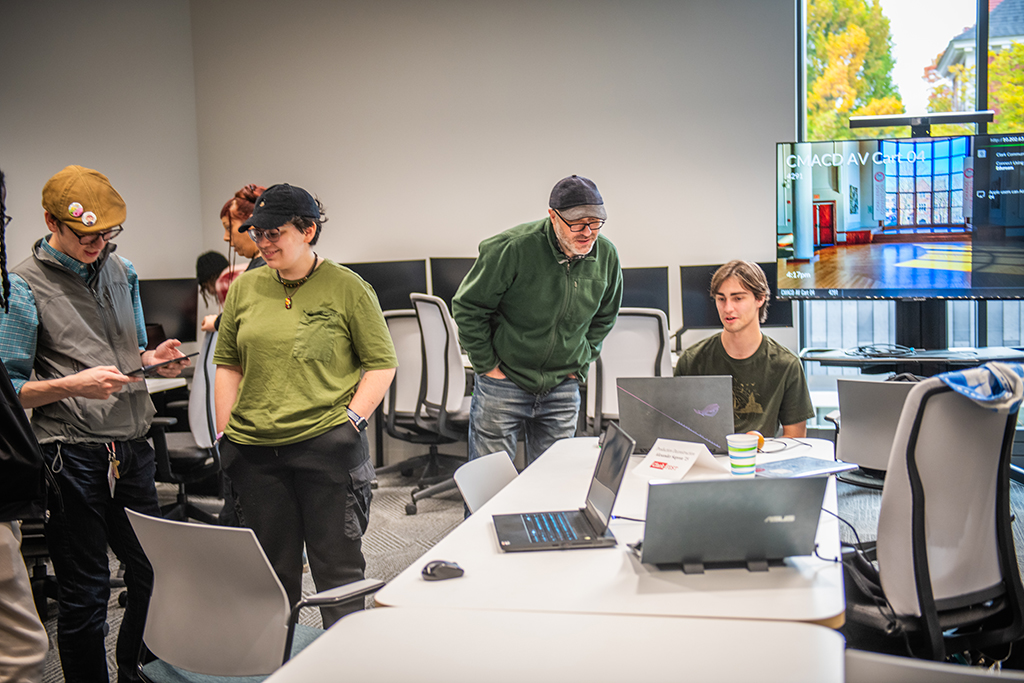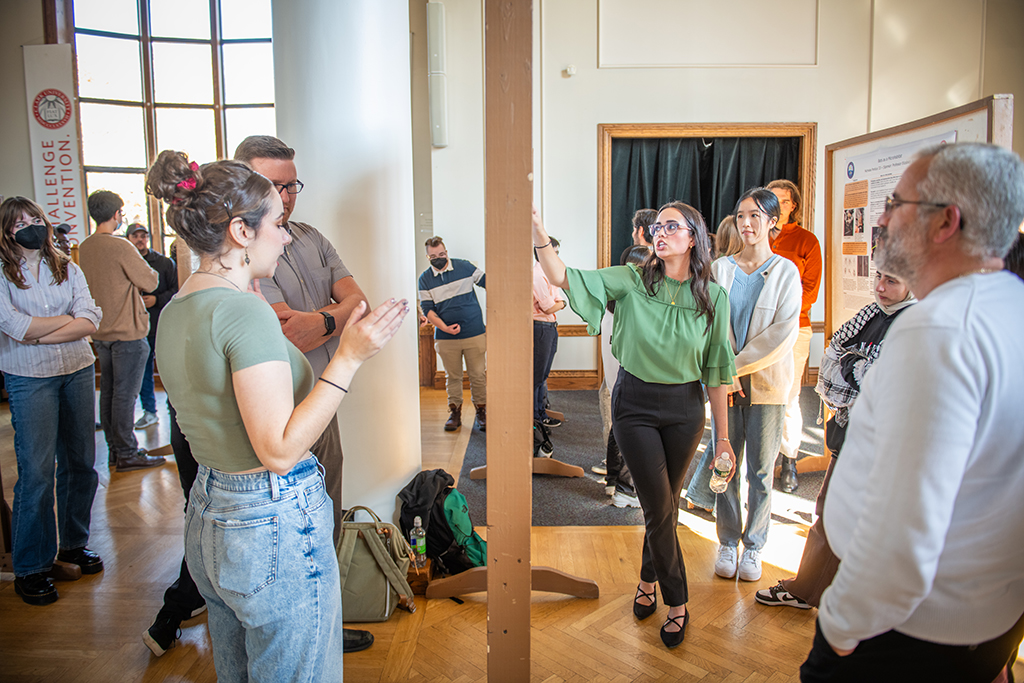Clark students bring out their best

Provost Sebastián Royo and Samuel Cooper ’24 share a laugh during ClarkFEST on Oct. 25. See more photos in the gallery below the story.
ClarkFEST Fall 2023 yesterday celebrated the intellectual and creative energies of Clark students, and their collaboration with faculty mentors, through an exhibition of posters and creative works in Tilton Hall, interactive media exhibits in the Center for Media Arts, Computing, and Design, and paper presentations in ASEC. More than 90 students presented on over 60 wide-ranging topics. Below is a sampling of how our students continued the Clark tradition of challenging convention and changing our world.
Exercising your mind
Mindfulness is usually an inward practice. Psychology major Zachary Cooper ’24 wants to discover how mindful practices can help people relate better and avoid conflict.
Cooper, who was sponsored by Visiting Professor Justin LaPlante, is beginning work on a study that will test the validity of mindfulness exercises by focusing on interpersonal communication. His subjects will engage in an exercise like meditation and then make an argument about something innocuous, like preference for Apple products versus Android products. “People are more willing to show their heart when discussing things that aren’t a threat to their identity,” Cooper said.
The study subject will listen to a pre-recorded opposing argument, made either mindfully or mindlessly. Cooper plans to interview the subjects and gauge several things: whether their attitude changed and in what direction; interpersonal communication factors like warmth; and how the subject felt about the person making the opposing argument.
“Similarly designed studies usually have a power dynamic like doctor-patient or teacher-student,” said Cooper. “I’m focusing on interpersonal disagreement and trying to minimize negative outcomes by using mindfulness strategies.”
The microhabitat bat
Most bats have rabies, according to biology major Nicholas Pontius ’23. This means any parasites, hyperparasites, and pathogens that affect bats must have a resistance to rabies, and rabies within bats must be able to adapt to parasites, hyperparasites, and pathogens. For this reason, bats are understood as a microhabitat.
There is a correlation between the parasites and hyperparasites that impact bats and the diseases the mammals carry. Some people want to eradicate bats to halt the spread of disease. Research by Pontius, sponsored by biology Professor Elizabeth Bone, indicates eradication isn’t a solution.
“Bats are kind of like rats in the sense that they can adapt to their environment really well. Through increasing urbanization, we see bats starting to adapt to urban environments,” said Pontius. “Eradicating bats is not a practical solution to getting rid of their diseases. A more efficient approach would be to understand how bat microhabitats function to control disease spread.”
Stats tell the story
Over the summer, computer science students Dillon Remuck ’25, Shubham Kinger ’24, Kevin Braunwart ’25, and Jeffery Tang ’24 dove into data analytics. They used the programming language Python to scrape player and game statistics from the NBA and WNBA websites, hoping to find correlations.
Remuck said minutes played, free throws made, field goals made, and total points were correlating subsets. “What we took from that was the more minutes you play the more opportunities players have,” he said.
Their research highlighted a disparity between the NBA and WNBA. Players in the WNBA are on the court longer before they are substituted in comparison to their male counterparts. Remuck said this is because the WNBA has 10-minute quarters compared to the NBA’s 12 minutes.
The group, supported by computer science Professor Li Han, also analyzed five years of wins at home courts. It’s already surmised that teams have an advantage on their home court — and now Remuck and peers have the data to prove it.
Name those tunes
Isaac Schatia ’24 applied machine learning to investigate song lyrics, “scraping” the web for data that resulted in an assessment of 3,715 songs and 950,000 distinct pieces of data — noting the artists’ individual styles as well as instances of duplication among songs. The goal was to create a machine learning model capable of accurately classifying lyrics to each band.
The computer science major noted that the advantage of this technology is its ability to “predict unseen data” to make its calculations. Why song lyrics? It was a fun and interesting topic for the project, but the technology, Schatia says, could be applied to many different works “from Shakespeare to the bible.”
Schiatia was sponsored by Professor Ken Bayse.
Keeping the waters at bay
The obvious question for William Schecter ’24 was why a political science major would undertake a project that involved preparing New Hampshire’s coastal neighborhoods for major flood events. Wouldn’t flood mitigation be more suited to someone in a geography or science field?
In fact, Schecter notes, flood prevention is very political, and involves building local coalitions to strategize and executive initiatives to keep neighborhoods from being swamped. Working from a New Hampshire Sea Grant, Schecter collaborated with community members and local governing bodies to implement “natural barriers” that reduce flood risk — for instance planting beach grass to prevent dune erosion. “It’s as much political science as flood science,” he says, “and it shows the importance of community action”
Schecter is looking forward to a career that will merge his interest in community work with a desire to make natural settings more accessible to those who live with physical challenges. The Clark senior was sponsored by Professor Morgan Ruelle.
Venus uncovered
Emily Abney ’24 believes that to truly understand great works of art — the techniques that shape them, the history that informs them, the secrets they reveal — you must experience them in person. To that end, Abney spent last year in the Netherlands studying Italian Renaissance and Dutch Baroque works. This January, she will be returning to Italy, Venice specifically, to “walk the streets and live the life” that Venetian artists drew upon to create their Renaissance-era images.
Abney’s project — “The Birth of a Venetian Venus in American Fine Arts Institutions” — explores the often-complicated perceptions and reactions from audiences when regarding the naked female form, centering on depictions of the goddess Venus. The art history major traveled to New York City and Seattle with funding provided by the Sarah Bickman Music and Arts Summer Internship Award to conduct her research. She took particular joy in studying Paolo Veronese’s “Venus and Adonis” at the Seattle Art Museum, the better to understand its “texture, its tactility, and its sensuality” and the context around its reception by Venetian audiences in the 16th century.
Abney, who was sponsored by Professor John Garton, is an art history major.
Digging into an island’s past
Peyton Dauley ’24 spent much of the summer as a Sheldon Hackney Fellow in the Curatorial Department of the Martha’s Vineyard Museum, a century-old historical and cultural museum that collects art, artifacts, oral histories, documents, and photographs that help tell the island’s stories. Dauley worked alongside the museum’s collections manager and conducted research to catalog individual items, including blacksmithing pieces from the mid-18th to early-19th centuries, directly into the museum’s database.
The history major, whose internship was supported by funding from the Department of History, also learned about nonprofit management and “how to create a cultural institution that caters to the present day as much as the past,” she said, and which represents its community well. For example, from 1694 to 1952, Martha’s Vineyard had an unusually large deaf population — and Dauley helped set up an exhibit about it and the sign language created there.
She also created research guides focusing on Black and indigenous women on the Vineyard, taking secondary sources from her Clark classes and applying them to archival material. “There hasn’t been a lot of research done on the Vineyard,” she said.
Dauley was sponsored by Professor Amy Richter.
The risky business of municipal bonds
Samuel Cooper ’24 worked this past summer with Professor Mark Davidson to examine how cities are disclosing climate change-related risk when applying for municipal bond funding.
Cooper identified the ten U.S. cities most at risk for a range of disasters — flooding, drought, extreme heat, wildfires, and hurricanes — and then looked at how those cities disclose their risk level to bond investors. Three of those cities — Phoenix and Tucson, Arizona, and Wilmington, Delaware — do not disclose any risk or include any information about how the city is preparing for climate change impacts, despite data from FEMA ranking their risks as moderate to high.
New York, Cooper found, not only discloses its risks but also, for general obligation bonds (as opposed to special revenue bonds that are paid back from a dedicated fund), includes a four-page document showing the cost of past storms and current efforts to mitigate climate impacts.
“We’d like to see more in financial markets addressing the issue and giving the investors what they need to know to make wise decisions,” Cooper said.
Cooper is an environmental science and policy major with an urban studies concentration. After graduation, he hopes to work in either planning or urban design.
Lobbying and the law
With the support of a Harrington Public Affairs Fellowship, Lily Summerfield ’26 spent her summer working at Shenker, Russo and Clark, an Albany, New York, law firm focused on lobbying and government relations. Along with researching the cannabis industry in New York, she attended union meetings and was involved in the preparations for the annual New York Pipe Trades Convention, which involved writing the legislative agenda, learning about the convention speakers, and interacting with state officials. “I got to hear the president of the New York Pipe Trades Association reading my writing, which was kind of wild,” Summerfield said.
During the second part of her internship, Summerfield worked on the law firm’s Walgreens Project, which was focused on updating the retail chain’s alcohol licensures. “My job was to search 482 towns and counties in New York to find out their zoning laws,” she said.
Summerfield is a history and political science major. She was sponsored by Professor Rob Boatright.
Supporting students with disabilities
This summer, Angela Patric ’24 surveyed a small group of Clark students with disabilities to learn how welcome and supported they feel at the University. The disabilities reported included ADHD, anxiety, and other neurodiverse conditions, as well as physical conditions, including heart issues and partial hearing loss.
In her study, Patric looked at the students’ experiences with both formal and informal supports on campus. The survey participants reported that they had some challenges with accessing formal supports — University offices, departments, and programs designed to assist students with disabilities — so didn’t use those services as much, but they did appreciate the informal supports offered by peers and professors.
Patric found that the students who had interacted with formal student support services had mixed experiences, with mostly positive experiences with professors, peers, and the general atmosphere at Clark. The attitudes and actions of Clark students, faculty, and staff do align with the positive, inclusive message shared in Clark’s admission materials, Patric said, despite some negative experiences reported by her survey participants, and she included both the positive and negative in her study. “I wanted to make sure I represented Clark fairly.” She was sponsored by Professor Tyran Grillo.
The data are in the wind
On the roof of Clark’s Biophysics building sits an anemometer, a device used to measure wind speed. Before this year, however, the data it gathered didn’t go anywhere. Sydney Lyons ’26 has changed that.
Lyons, a physics major whose project was funded by an Erickson Research Award and sponsored by Professor Charles Agosta, modified a circuit board so it could receive the anemometer’s signal, which then travels along a wire through the building; in the process, it picks up electrical noise from other wires and systems. To read the analog signal properly, extraneous noise must be filtered out, and Lyons adapted the circuit board to do just that. The converted digital signal is then interpreted by the computer and output as wind speed.
“To optimize the power output from wind turbines, you need to optimize the rotational speed of the turbine itself with whatever the wind speed is at that time,” Lyons said. Her project’s goal is to improve renewable energy output.

